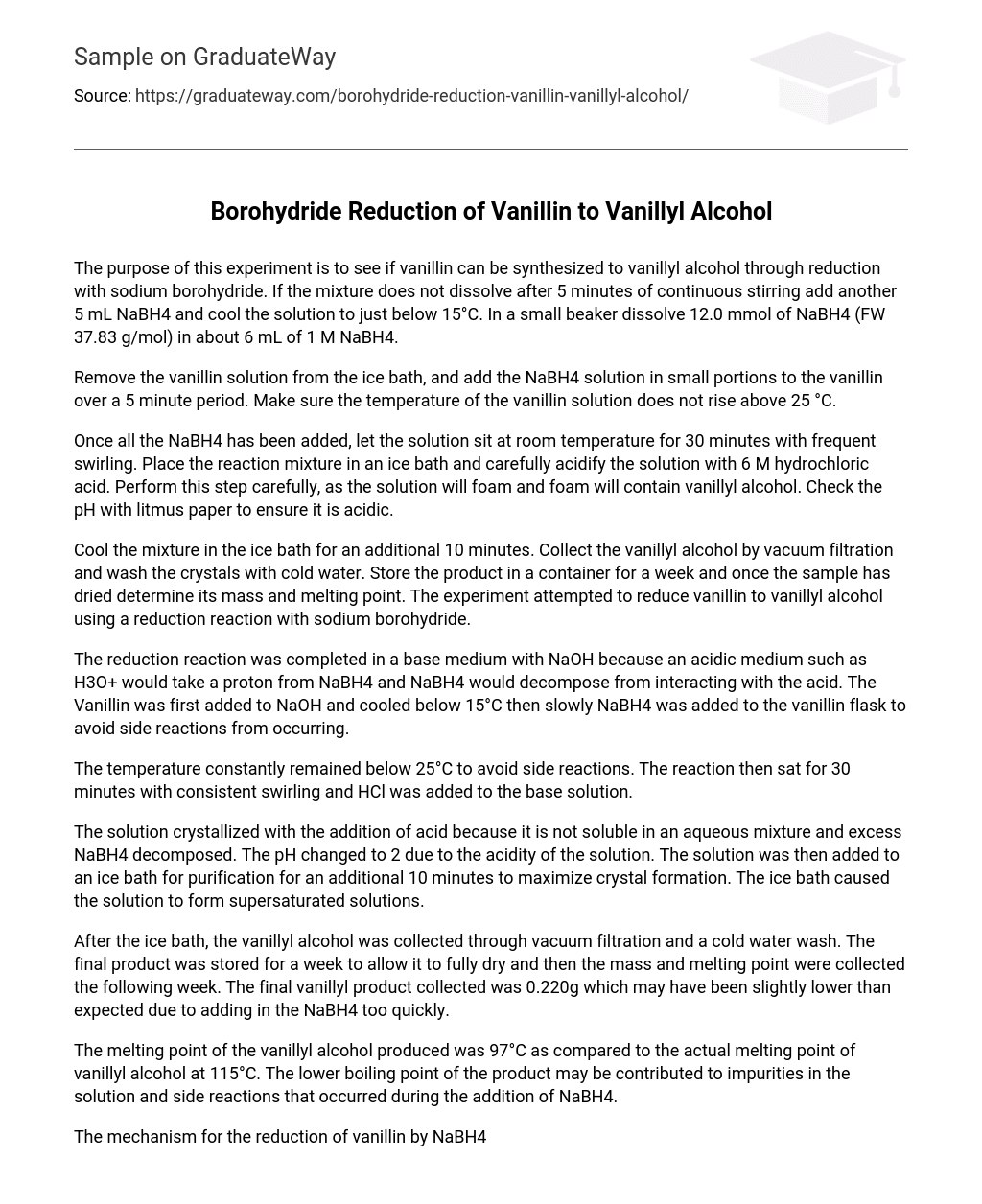The purpose of this experiment is to see if vanillin can be synthesized to vanillyl alcohol through reduction with sodium borohydride. If the mixture does not dissolve after 5 minutes of continuous stirring add another 5 mL NaBH4 and cool the solution to just below 15°C. In a small beaker dissolve 12.0 mmol of NaBH4 (FW 37.83 g/mol) in about 6 mL of 1 M NaBH4.
Remove the vanillin solution from the ice bath, and add the NaBH4 solution in small portions to the vanillin over a 5 minute period. Make sure the temperature of the vanillin solution does not rise above 25 °C.
Once all the NaBH4 has been added, let the solution sit at room temperature for 30 minutes with frequent swirling. Place the reaction mixture in an ice bath and carefully acidify the solution with 6 M hydrochloric acid. Perform this step carefully, as the solution will foam and foam will contain vanillyl alcohol. Check the pH with litmus paper to ensure it is acidic.
Cool the mixture in the ice bath for an additional 10 minutes. Collect the vanillyl alcohol by vacuum filtration and wash the crystals with cold water. Store the product in a container for a week and once the sample has dried determine its mass and melting point. The experiment attempted to reduce vanillin to vanillyl alcohol using a reduction reaction with sodium borohydride.
The reduction reaction was completed in a base medium with NaOH because an acidic medium such as H3O+ would take a proton from NaBH4 and NaBH4 would decompose from interacting with the acid. The Vanillin was first added to NaOH and cooled below 15°C then slowly NaBH4 was added to the vanillin flask to avoid side reactions from occurring.
The temperature constantly remained below 25°C to avoid side reactions. The reaction then sat for 30 minutes with consistent swirling and HCl was added to the base solution.
The solution crystallized with the addition of acid because it is not soluble in an aqueous mixture and excess NaBH4 decomposed. The pH changed to 2 due to the acidity of the solution. The solution was then added to an ice bath for purification for an additional 10 minutes to maximize crystal formation. The ice bath caused the solution to form supersaturated solutions.
After the ice bath, the vanillyl alcohol was collected through vacuum filtration and a cold water wash. The final product was stored for a week to allow it to fully dry and then the mass and melting point were collected the following week. The final vanillyl product collected was 0.220g which may have been slightly lower than expected due to adding in the NaBH4 too quickly.
The melting point of the vanillyl alcohol produced was 97°C as compared to the actual melting point of vanillyl alcohol at 115°C. The lower boiling point of the product may be contributed to impurities in the solution and side reactions that occurred during the addition of NaBH4.
The mechanism for the reduction of vanillin by NaBH4
- a) Using pure water instead of sodium hydroxide would decompose the reagent since it is in an aqueous solution and not stable at a neutral or acidic pH. Hydrogen gas would be produced similar to what occurs in the experiment from addition of HCl with the excess NaBH4.
- b) Using 5 mL of 1M NaOH for the BH4 solution would not cause much of a difference. However, using 10 mL of 1M NaOH for the vanillin solution would result in insufficient solvent for the vanillin to react with and lower product yield.
- c) If 50mmol of NaBH4 were used instead of 12mmol of NaBH4, the reaction would have a large amount of excess NaBH4 and would create extra hydrogen gas and possibly more side reactions as well.





